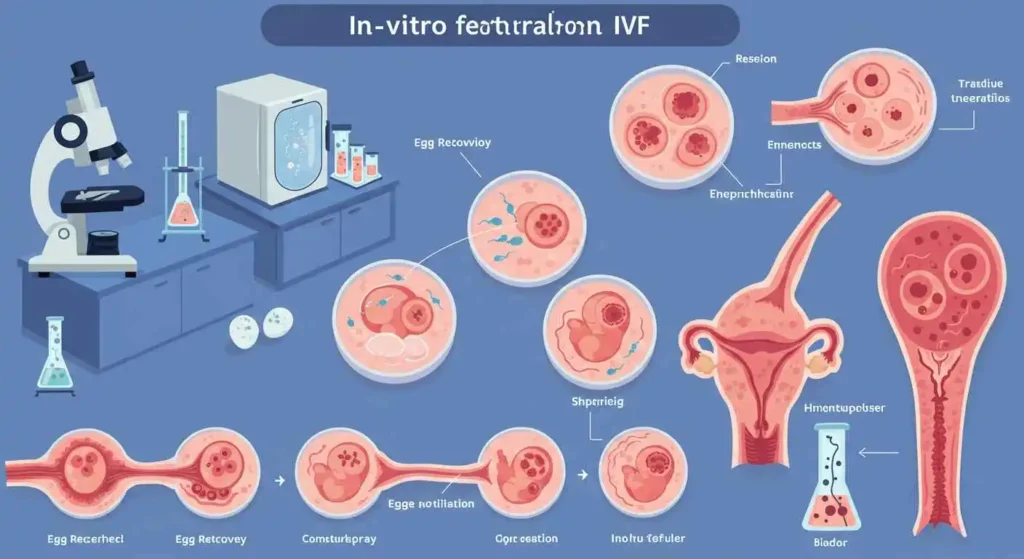Science has provided solutions to millions of people who struggle with infertility. The Project on Assisted Reproductive Technology explores not only how modern medical treatments help couples conceive but also the historical journey, ethical considerations, and real-life impacts of these treatments.
The guide is written using simple human language to make it easy for students, teachers, and curious readers to understand the subject. You’ll find case studies, anecdotes, and step-by-step instructions, as well as references to useful resources.
Project on Assisted Reproductive Technology for Class 12
You should concentrate on the following when working on a project for class 12:
-
The definition of ART is medical methods to overcome infertility.
-
Examples: In Vitro Fertilization (IVF), Intrauterine Insemination (IUI), and Intracytoplasmic Sperm Injection (ICSI).
-
Impact on Society: ART is a great way to bring joy to millions of people.
Anecdote—One biology teacher told her students, “When I explain ART to my students, I don’t only show them diagrams; I also tell them the story of Louise Brown, who was the first IVF child. This story helps them understand how science can change lives.”
Project on Assisted Reproductive Technology PDF
Students are often looking for a project on assisted reproduction technology PDF as a resource. A good PDF includes:
-
Definition and introduction
-
Step-by-step explanations
-
Charts and Diagrams to clarify
-
Case Studies demonstrating real-world examples
-
Summary and References
Platforms like NCBI provide reliable references that you can adapt to your project.
Project on Assisted Reproductive Technology PDF Class 12
To prepare for the exam, a PDF for class 12 should be aligned to the NCERT guidelines. It includes:
-
Definition of infertility
-
Causes of infertility in both males and females
-
A brief overview of ART Methods such as IVF, IUI, and ICSI
-
The advantages and disadvantages of ART
-
Diagrams
The book helps students to prepare for their board exams by connecting science to everyday life.
Case study on Project on Assisted Reproductive Technology
The case studies on assisted reproduction technology bring projects to life. Here’s an illustration:
-
A couple was married for eight years, but they struggled to conceive due to a blocked fallopian tube.
-
Treatment was chosen instead of a solution. They successfully conceived after two cycles.
-
Outcome A healthy baby has been born, proving ART’s life-changing potential.
This type of case study makes your project relatable and, therefore, more impactful.
History and Development of Assisted Reproductive Technologies PDF
The History of Assisted Reproductive Technology. The PDF shows us how far we have come in science.
-
Early embryo experimentation in animals, 1950-1960s
-
1978 Birth of Louise Brown—the first IVF child.
-
1990s: development of ICSI (direct sperm infusion into the egg).
-
The 2000s and beyond: Surrogacy, genetic screening, and egg freezing.
This timeline shows the evolution of ART from dangerous experiments to a safe and widely used medical procedure.
Ethical Aspects and Legal Aspects Of Assisted Reproductive Technologies PPT
The presentation on the ethical and legal issues of assisted reproduction technology should include:
-
Ethical Debates
-
Should women over a certain age continue to use ARTs?
-
Is it morally correct to select women for a job?
-
How should embryos that are not used be handled?
-
-
Legal issues:
-
Surrogacy laws differ across countries.
-
Surrogacy is permitted in some countries, but not all.
-
Tip: Use real-life cases or laws in your presentation to make it more engaging.
Multiple-Choice Questions on Assisted Reproductive Technologies
Include multiple-choice questions about assisted reproductive technologies to test your knowledge.
-
The first ART method to be successful was:
a. IUI
b. IVF
c. ICSI
d. Surrogacy -
The first IVF child was:
Elizabeth Blackwell
Louise Brown
Mary Edwards
Jane Long -
Which ART technique involves direct sperm infusion into the egg
a. IVF
b. IUI
c. ICSI
d. Surrogacy
Answers: 1-b, 2-b, 3-c
Assisted Reproductive Techniques PPT
Include the following in your presentation on assisted reproduction techniques:
-
Flowcharts that show the IVF procedure in detail
-
Lab Equipment Images: To visualize the process
-
Comparison Charts for IVF, IUI, and ICSI
-
Global Statistics on ART Success Rates and Usage
Visuals help to make concepts easier to understand and engage the audience.
Step-by-step guide: How to make a project on ART
Here’s an easy way to do it:
-
Choose a focus: IVF, surrogacy, or ethics.
-
Collect Resources: Use authentic PDFs and medical journals.
-
Arrange sections: introduction, process diagrams, case studies, and conclusion.
-
Add visuals: diagrams, flowcharts, and PPT slides.
-
Edit and ensure that the language used is professional and clear.
Why this project is important
An assignment on assisted reproductive technologies is much more than just a biology project. It’s an investigation of the role that science plays in our lives. Couples who thought it was impossible to have children now can look forward to a brighter future. Students should not only focus on exams when learning about ART. They must also understand how science can solve real-world problems.
Final Words
Students can apply classroom learning in the real world by creating a project on assisted reproduction technology. Your project will be more impressive if you use a proper structure and include reliable references, illustrations, case studies, or multiple-choice questions.

